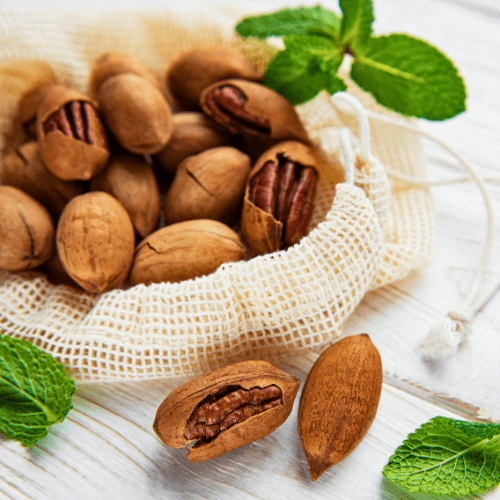Position
Full sun is best for pecan nut trees. Choose a location that is not prone to flooding and has good air circulation. Dig a hole of at least 1 metre wide and 2 metres deep. Fill the hole with water before planting your tree to the same level as in the nursery pot. Allow 10 metres around the tree and a distance from structures and power lines. Keep the soil around the tree free from weeds and grasses.
Size
A pecan nut tree can grow extremely tall between 20-40metres. Top a new tree to a height of 1 metre to encourage branching, which forms a framework.
Soil Type
Pecan nut trees prefer well-drained soil that is deep and fertile. They can tolerate a range of soil types but do best in loamy soils with a pH between 6.0 and 7.0.
Soil should be rich in organic matter. Adding a bag of acid compost and well-rotted manure before planting can improve soil structure and fertility.
Mulch
Apply organic mulch to your pecan nut tree all year round.
Use from 2 to 5 centimetres of pine bark mulch to protect the roots from UV damage and drying out. It retains moisture, and maintains an optimal pH. Do not let the mulch touch the plant stem, as it may cause infection or rot.
Watering
Regular watering is essential for young, newly planted trees. Water them very well and deeply once a week for the first 2 years. For mature trees, soil moisture determines the yield, size and fullness of nuts and the amount of new growth. Water them often enough to keep the soil evenly moist from when the buds swell until harvest. Drip irrigation or deep watering works well to promote deep root growth.
Fertilising
Pecan trees require nitrogen, phosphorus, and potassium, and our slow-release nitrogen-rich all plant fertiliser should work well. Apply 1 teaspoon every 4-5 months. The roots will absorb what they required.
Pruning
Pruning is important to maintain the tree’s shape and remove dead or damaged branches. Top a new tree to a height of 1 metre to encourage branching, which forms a framework.
Pecans have a high canopy, so pruning in early spring is advised to improve air circulation and sunlight penetration.
Avoid prune too aggressively, as it could reduce future nut yields.
Pests
Aphids, snails, slugs and borer are the greatest enemies of pecan nut trees. Inspect them regularly and use an organic pesticide if necessary. Paint the trees with white interior latex paint mixed in equal parts with water to protect them from sunburn and attack by flathead boring beetles.
Harvesting
Pecan nuts are usually harvested between April and July in South Africa. When they are ripe, their green husk dries and splits open, allowing the nut to fall out.






